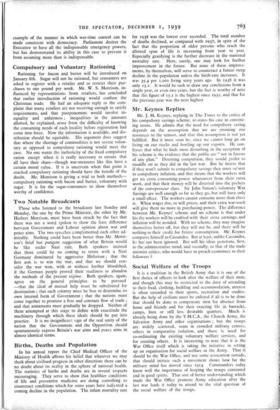Births, Deaths and Population
In his annual report the Chief Medical Officer of the Ministry of Health affirms his belief that whatever we may think about civilised progress in other directions there can be no doubt about its reality in the sphere of national health. The statistics of births and deaths are in several respects encouraging. They serve to show that healthier conditions of life and preventive medicine are doing something to counteract conditions which for some years have indicated a coming decline in the population. The infant mortality rate for 1938 was the lowest ever recorded. The total number of deaths declined, as compared with 1937, in spite of the fact that the proportion of older persons who reach the allotted span of life is increasing from year to year. Especially gratifying is the further decrease in the maternal mortality rate. Here, surely, one may look for further improvement in the future. But none of these improve- ments, by themselves, will serve to counteract a future steep decline in the population unless the birth-rate increases. It was 35.4 per r,000 living sixty years ago. In 1938 it was only 15.r. It would be rash to draw any conclusions from a single year, or even two years, but the fact is worthy of note that this figure of 15.1 is the highest since 1932, and that for the previous year was the next highest












































 Previous page
Previous page